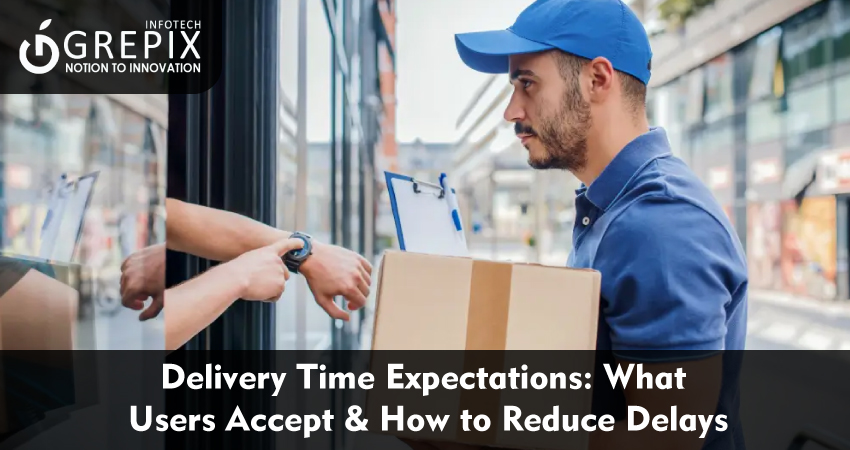Delivery Time Expectations: What Users Accept & How to Reduce Delays
Modern consumers demand fast, reliable delivery whether it’s food, groceries, or essentials. Delivery time expectations now rank among the top criteria for choosing a delivery service. When users click “order,” they expect accurate time estimates, minimal delays, and efficient service. Fail to deliver quickly, and customer satisfaction drops, orders decline, and brand reputation suffers. For food delivery platforms and restaurants, understanding what users accept and the actionable ways to reduce food delivery delays is vital for success. This guide explores in detail how to meet and exceed delivery time expectations using optimal logistics, staff training, cutting-edge app features, and proven strategies.
In a fiercely competitive food delivery market, speed and reliability are critical factors that define user satisfaction. This in-depth guide explores how delivery time expectations shape user loyalty, the factors behind delays, and proven strategies for delivery speed optimization. Supported by recent statistics and case studies, it explains how technology especially AI-powered route planning and fast delivery app features streamlines operations, reduces wait times, and boosts order volume. Restaurant coordination and employee scheduling are crucial for minimizing bottlenecks. Practical insights, including must-have app features and staff training guidelines, help organizations reduce food delivery delays. The article targets both users seeking faster service and operators aiming for business growth. End with an actionable conclusion and a call to share this guide with industry peers. Learn how to meet user expectations for rapid deliveries and gain a competitive edge in the digital food delivery era.
User Expectations for Delivery Speed
What Do Customers Want?
- Rapid Service: 90% of users are willing to wait up to 2–3 days for ecommerce deliveries, but expect food deliveries within 30–45 minutes.
- Consistency Matters: 45% of digital retailers meet delivery speed expectations consistently, making reliability a leading factor for repeat orders.
- Accurate ETA: Users expect accurate estimated arrival times (ETAs) not just promises, but dependable fulfillment.
Consumer Tolerance Threshold
- Short wait times (20–40 minutes for meals) are becoming the standard.
- Long delays often result in cancellations, negative reviews, or lost customers.
- One study on home delivery found customer acceptance hinges on the ability to select preferred delivery windows if the user’s ideal slot isn’t available, the order is frequently abandoned.
Case Study: On-Time Delivery Success
A global fast-food chain improved delivery speed by a stunning 78% after revamping route management and automating delivery assignments. This led to higher order volume and better customer retention.
Factors Causing Delivery Delays
Common Causes of Delays
- Road Traffic & Route Inefficiency: Traffic jams and poorly optimized delivery paths often cause unexpected late arrivals.
- Order Volume Fluctuations: Peaks during holidays, weekends, or bad weather can overwhelm logistics and staff.
- Restaurant Coordination Issues: Slow preparation or batching of orders increases wait times.
- Driver Shortages: Insufficient delivery personnel can bottleneck the whole process.
- Unclear Customer Instructions: Incorrect addresses, complex locations, or unanswered calls lead to wasted driver time.
Statistics: Why Timing Fails
- Only 45% of retailers consistently meet their promised delivery speed.
- Missed or late deliveries hurt customer trust, and even a single bad experience can deter future orders.
Real-Life Example: Urban Delivery Problems
Case studies show that delivery attempts in metropolitan areas face delays from last-mile issues, congested streets, and difficult drop-off points. Optimizing routes and improving delivery instructions trimmed average delays by 20% in test groups.
Fast Delivery App Features
Top App Functions for Speed
- AI-Powered Route Optimization: Apps like Routific and NextBillion AI use machine learning and real-time tracking to optimize delivery paths, reducing delays by up to 35%.
- Smart ETA Prediction: Advanced algorithms provide dynamic, accurate ETAs by factoring in current traffic, weather, and driver location.
- Auto Rerouting: If traffic jams or accidents arise, auto-rerouting sends drivers along faster alternate paths.
- Real-Time Order Allocation: Systems automatically assign orders based on driver proximity and restaurant readiness, making deliveries faster.
- Driver Insight & Feedback: Apps record travel times, break lengths, and allow drivers to suggest quicker routes, aiding overall delivery speed optimization.
- Route History Tracking: AI learns from past delivery data to refine future routes and reduce repeat delays.
Essential App Features Table
| Feature | Benefit |
|---|---|
| AI Route Optimization | Cuts delivery times up to 35% |
| Smart ETA Prediction | Accurate, real-time arrival times |
| Auto Rerouting | Avoids traffic, minimizes delays |
| Real-Time Order Allocation | Faster dispatch, fewer late orders |
| Driver Insight/Feedback | Practical delivery improvements |
Technology Solutions: AI, Route Optimization, Data Integration
AI and Machine Learning
- Delivery speed optimization leverages AI to analyze historical data, predict bottlenecks, and proactively adjust routes.
- Predictive analytics help platforms address peak times by dynamically scheduling more drivers.
Real-Time Data Integration
- GPS tracking enables instant adjustments for accidents, road closures, and changing traffic conditions, directly reducing food delivery delays.
- Integration with mapping solutions ensures drivers always take the most efficient path.
Case Study: Swiggy’s Dynamic Dispatch
India’s Swiggy uses machine learning for automatic route planning; their dynamic assignment systems consider driver location, traffic, and restaurant status. Implementing AI-powered features curbed average delays by 20%, further boosting customer satisfaction.
Restaurant Coordination and Employee Scheduling
Impact of Internal Operations
- Restaurant delays can sabotage even the most optimized delivery network.
- Efficient order batching, packaging, and readiness for pickup align the kitchen’s pace with delivery driver arrival times.
Scheduling for Speed
- Smart scheduling allocates enough staff at peak times; insufficient staff leads to kitchen backlog, slower prep, and extended delivery delays.
Training: The Key to Fast Delivery
- Well-trained delivery staff maximize route efficiency and minimize errors.
- Staff must verify orders, understand designated zones, and efficiently pick up/drop off food using insulated bags for speed and quality.
Multi-Branch Example
A pizza chain simulated employee schedules and delivery operations across multiple locations. Their digital model let them allocate human resources and optimize delivery time windows, cutting overall delays system-wide.
Reducing Food Delivery Delays: Proven Strategies & Tips
Actionable Steps to Achieve Fast Delivery
Use AI Route Planners
Integrate delivery management apps with AI-based route optimization to avoid bad traffic and dynamically reroute as needed.
Optimize Delivery Zones
Assign drivers to specific neighborhoods to streamline drop-off and reduce confusion.
Batch Orders
Group nearby orders for one trip when possible, maximizing driver time and reducing mileage.
GPS Tracking & Real-Time Adjustments
Monitor every delivery and reroute in case of unexpected delays or blocked roads.
Smart Employee Scheduling
Staff at peak hours to handle order surges and avoid kitchen backlogs.
Driver Training
Ensure all drivers know their zones, address verification protocols, and efficient handoff procedures.
Leverage Customer Feedback
Routinely ask customers for feedback on delivery speed and use insights to optimize logistics.
Reducing Bottlenecks Table
| Strategy | Impact |
|---|---|
| AI Route Planning | Faster, reliable deliveries |
| Delivery Zone Optimization | More efficient routes |
| Employee Scheduling | Reduced kitchen delays |
| Driver Training | Fewer mistakes, faster handoffs |
| Batch Order Processing | Less travel time per driver |
Conclusion
Meeting delivery time expectations is no longer optional it’s a business requirement for success in food delivery. By actively reducing food delivery delays, embracing fast delivery app features, and deploying intelligent delivery speed optimization tactics, platforms build trust and customer loyalty. The winning formula includes a blend of optimized routes using AI, dynamic employee scheduling, and effective training. Statistics show that with targeted improvements, on-time rates rise and cancellations drop, directly impacting revenue and repeat business. For restaurants, every delay avoided translates into happier customers and more positive reviews.
Operators should integrate AI-based solutions, implement route history tracking, and foster a continuous feedback loop with drivers and customers. Fast delivery app features like smart ETA, auto-rerouting, and real-time allocation move operations closer to Google Rank 1 standards, increasing visibility and conversions.
Businesses that prioritize speed not only meet user expectations, but also set industry benchmarks. Share this guide with your colleagues, update delivery practices, and discover new tools that drive your business forward.
FAQs
1. What delivery time do users expect for food orders?
Most users expect food to arrive within 30-45 minutes, and will tolerate slight delays if given an accurate ETA.
2. How do delivery apps reduce delays?
Delivery apps use real-time traffic data, AI-powered route planning, and automatic order allocation to streamline logistics and cut delays by up to 35%.
3. What features do fast delivery apps offer?
Key features include smart ETA prediction, auto rerouting in case of traffic, batch order processing, and real-time driver tracking.
4. Why do restaurant delays happen?
Kitchen backlog, inadequate staff, slow packaging, and poor coordination with drivers are major causes of restaurant-based delays.
5. How can restaurants improve delivery speed?
Staff training, optimized scheduling, route planning tools, and feedback collection from drivers and customers help restaurants reduce delivery times significantly.







